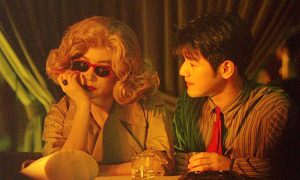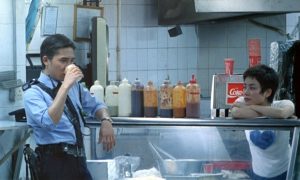Chungking Express, Tsim Sha Tsui, Hong Kong
Wong Kar Wai (1994)
“Every day we would get lots of chances to walk past many people, even though we may have no chance to talk or get to know them, but they might be your friends at the end.” said “police 223” in Chungking Express (acted by Gam Sing Mou)
In the movie, two separate and similar love stories are linked by the same place——— the Chungking Mansion. The two stories were “police 223” and “police 663” have broken up with their girlfriends and fell in love with a female killer and a waitress respectively. The subtle differences of these typical love stories and the usage of “police 223” and “police 663” instead of mentioning their names have emphasized that they are just ordinary people in the city, which have successfully raised the awareness and echo with the audiences. However, what I am about to focus on is the deeper meanings conveyed in the film through connecting the place of filming and the storyline. Many scenes in the movie are set and taken inside the Chungking Mansion. The director of the film, Mr. Wong Ka Wai insisted on taking those scenes in the Chungking Mansion even though the official request for filming has been turned down and rejected by the authorities. But we could quickly understand the reason for his persistence. One of the core meanings and reflections that the film wants to convey is that Hong Kong is a cultural hybrid city, where the Chungking Mansion is definitely the best place to the incarnate cultural diversity of Hong Kong.


The reality of Chungking Mansion in Tsim Sha Tsui is a place that shows the diversity of races in Hong Kong, with many ethnic minorities including Pakistani, Indian people living and working inside. To many Hong King citizens in the past, before the film is released, Chungking Mansion might seem to be the most dangerous place in Hong Kong, owing to social stereotypes of discrimination against the ethnic minorities, believing that there are illegal deals as well as unrevealed crimes happened there. However, the film showed some contrasts and unleashed the most mysterious part of the Chungking Mansion, showing the dynamic and bright side of this place, as well as the warmth among people. After the release of the movie, Hong Kong citizens have become more open-minded or even appreciate this “exotic” place in Hong Kong. Anthropology Professor from the Chinese University Gordon Matthews (2011) has also mentioned that the Chungking Mansion is demonstrating low-key globalization. The bright side of the Chungking Mansion has been shown.


At the beginning of the blog, a dialogue from the film is shown, this dialogue has further elaborated on the meaning and message delivered by the film. In the movie, the main characters have walked past each other before they actually met and fell in love with one another, which proved what Gam Shing Mou has said at the beginning of the film.
From my understanding, apart from the romantic relationship shown in the film, interaction among people of different races, skin color, and background is also emphasized in this movie. Since the film is set in the Chungking Mansion, with many ethnic minorities live there, the hidden meaning inside is cross-races friendship or relationship could also be built if we could remove our prejudice, as the passerby in the Chungking Mansion are of different races (further connect to what Gam Shing Mou has said). This helps further explain why Mr. Wong Kai Wai insisted on filming the movie in the Chungking Mansion, to deepen the meaning of the film.
—- Marco, Poon Kwan Yiu 3035797432
Reference List:
1.)Wong K.W. (1997), Chungking Express (film dialogue)
2.)Matthews G. (2011). Ghetto at the Center of the World: Chungking Mansions, Hong Kong, Hong Kong University Press.
Stills resources:
3.) https://today.line.me/tw/v2/amp/article/xglJLq
4.) https://www.hk01.com/電影/527688/王家衛獲批開拍-重慶森林2020-2036年故事線新增2個新角色
5.) https://fashion.sina.cn/2020-07-08/detail-iircuyvk2491588.d.html?from=wap
6.) https://www.backpackers.com.tw/forum/showthread.php?t=9997188
Appreciate your attempt to discuss Chungking Mansion as home to diverse groups and individuals through the two intersecting love stories though I am not sure that the two love stories in the movie are “typical.” Clarify? Perhaps rather than identify them simply as typical, focus on how they are told (and then reflect again whether you still find them “typical” and why you come to that conclusion). It is also curious, however, that there are no actual photographs of Chungking Mansions from your fieldwork. As your discussion progresses, it becomes increasingly ambiguous whether the discussion is informed by discoveries that you made during your fieldwork or otherwise. It is not clear what you mean in the captions “The reality of the Chungking Mansion (compare to how it is filmed).” There does not seem to be evidences of new insights – for example, what are similarities and differences in the people and activities at the podium floors of the Chungking Mansions between the 1994 film, Matthews’ 2011 book and 2021 that still subject to covid-19 pandemic social distancing measures. How has the face/s of racial and cultural diversity changed in these 3 decades in which the building is “entered” – through the film, the book and your own observations and analyses through the field trip?